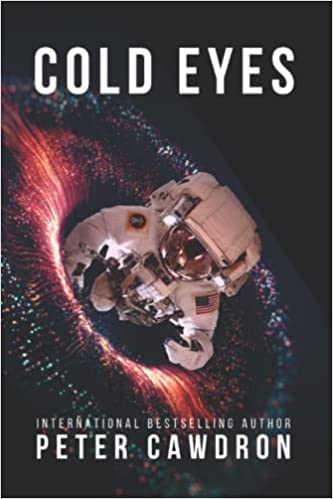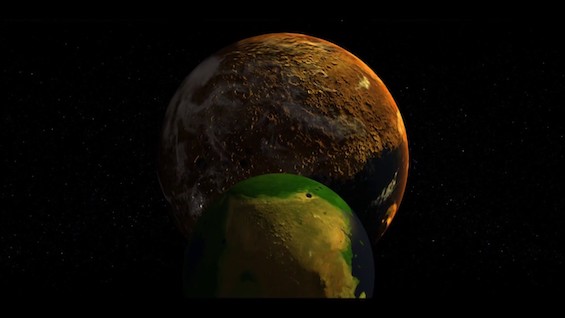
Dali Patel wakes up screaming. He thinks at first that he’s dead. He’s naked, trapped inside a narrow glass cylinder, and covered with goo. A young woman helps him out onto his feet. She explains that Dali is, in fact, a clone, hatched at the age of 18 aboard the UN starship Magellan. The two of them are half of the ship’s crew. She’s Sandra Anderson, the commander. But she is troubled that he doesn’t recognize her. Sandy, it turns out, was his wife of 42 years when they both inhabited the bodies of the people from whom they were cloned. And something has gone very, very wrong. Thus begins Peter Cawdron’s impressive tale, Cold Eyes, a novel about humanity’s First Contact with the people of a Super-Earth.
A Super-Earth within the habitable zone
The Magellan is en route to a Super-Earth, one of the most Earth-like planets ever discovered. It’s nearly three times as massive as Earth and tidally locked—a “cold eye”—with an enormous ocean on one side forever facing its star and a glacier covering the other in perpetual darkness. It’s a real exoplanet, and these are facts known to science today. The crew has christened the planet “Bee.”
Their mission is to establish First Contact with the inhabitants. They’re responding to a clear signal of intelligence replying to a message radioed to them in 2017. Unfortunately, Dali is the crew’s First Contact specialist. And his memory implant didn’t take properly, so he remembers none of the professional education his progenitor had received as a linguist or anything of his months of training. He’s forced to prove himself to his crew-mates—and to himself. Which, it turns out, is not easy.
Cold Eyes (First Contact #18) by Peter Cawdron (2021) 393 pages ★★★★☆

Trapped on the planet by heavy gravity
Dali and his 18-year-old crew-mates—Dr. Kari Ndiaye and Dr. Helios Christensen (another couple) as well as Sandy—exchange messages with the “Beebs” (as they call the inhabitants of Bee) on close approach to the planet. Two outstanding facts soon become clear. First, whoever they are, they’re extremely intelligent. They pick up almost instantly on Dali’s messages sent to establish a basis of communication. And, second, they are trapped on the surface, unable ever to visit the stars. The heavy gravity and dense atmosphere of Bee will not permit any conceivable rocket to obtain escape velocity.
Of course, the same factors make it impossible for the crew of the Magellan to land, because they would never be able to leave. Which means that Dali once again thinks he’s died when the delta-wing spacecraft he’s riding on a reconnaissance mission explodes high in the atmosphere. But he doesn’t die. Instead, he lands on Bee, where he quickly becomes caught up in a civil war between Bee’s two intelligent species. The people of this Super-Earth are in no way like humans physiologically, but they demonstrate very understandable behavior.
The scientific basis for this story
Cawdron’s tale is set on the planet we now know as Gliese 273b (or, more commonly, Luyten b). Here’s what Wikipedia tells us about it: Luyten b “is a confirmed exoplanet, likely rocky, orbiting within the habitable zone of the nearby red dwarf Luyten’s Star. The planet orbits its star at a distance less than one-tenth as far as Earth is from the sun. It is one of the most Earth-like planets ever found and is the fifth-closest potentially habitable exoplanet known. Luyten b has around 2.89 times the mass of Earth—which makes it a Super-Earth—and receives only 6% more starlight, thus constituting one of the best candidates for habitability. In October 2017 and 2018, the nonprofit organization METI (Messaging Extraterrestrial Intelligence) sent a message containing dozens of short musical compositions and a scientific “tutorial” towards the planet in hopes of contacting any potential extraterrestrial civilizations.” The conceit at the basis of Cawdron’s tale is that a response to this message from the planet has triggered Dali’s interstellar mission.
The thinking behind the novel
In a lengthy Afterword, Cawdron shares the thinking behind the novel and cites the scientific sources of his reasoning. All his books feature such discussions, which I regard as a generous gift to us readers. His knowledge of the science underlying the story is impressive. If you’re tempted to skip the Afterword, thinking it’s the usual sort of recitation of people who helped the author, don’t. It’s well worth reading.
Cawdron may cause you to think about things that have never occurred to you before. For example:
- What’s normal? “On a cosmic scale, ‘normal’ is -455F and roughly one minuscule atom for every cubic inch. There’s nothing normal about life. Life is decidedly abnormal.”
- What is intelligence? “Intelligence is an arm wrestle against the base nature of fight-or-flight. It’s the only reasonable alternative to instinct. Intelligence thrives on hope.”
- Why is the speed of light a limit? “When you consider the impact of speed on time, it becomes obvious why there’s a cosmic speed limit. It’s not speed itself that’s limited. The problem is time. Time can only slow until the point it stops—and the point at which time comes to a halt is the speed at which light travels! To go faster, you’d need to go backward in time. Although that might appeal to our science-fiction-addled minds, it’s nonsense.”
For more reading
This is one of the novels in Peter Cawdron’s insightful First Contact book series.
For more good reading, check out:
- The ultimate guide to the all-time best science fiction novels
- 10 top science fiction novels (plus lots of runners-up)
- Good books about space travel, including both nonfiction and fiction
- The 15 best First Contact novels
- Seven new science fiction authors worth reading
And you can always find my most popular reviews, and the most recent ones, plus a guide to this whole site, on the Home Page.

























